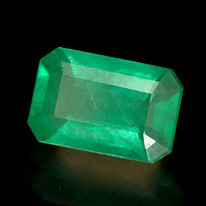The Gemstone Emerald

Emerald, the green variety of Beryl, is the most famous and valuable green gemstone. Its beautiful green color, combined with durability and rarity, make it one of the most expensive gemstones. Deep green is the most desired color in Emeralds. In general the paler
the color of an Emerald, the lesser its value. Very pale colored stones
are not called Emeralds but rather "Green Beryl". They are sometimes
heat treated, which causes their color to turn blue and transform into Aquamarine.
Chemical Formula
?
Be
3Al
2Si
6O
18
Mineral Class
?
Beryl (
Emerald)
Additional Properties
|
Refractive Index
?
1.57 - 1.58 |
Double Refraction
?
.006 |
Transparency
?
Transparent to translucent |
SG
?
2.6 - 2.8 |
Luster
?
Vitreous |
| Cleavage ?
3,1 - basal |
All About
Besides for Emerald, the mineral
Beryl also has other important gem varieties,
including blue
Aquamarine, pink
Morganite, and yellow
Heliodor/
Golden Beryl Pure Beryl is
white; the green color of Emerald is usually caused by chromium
impurities,
and occasionally by vanadium impurities. Emerald is by far the most valuable gemstone variety of Beryl, being one of the few precious gemstones.
Emeralds are notorious for their
flaws.
Flawless stones are very uncommon, and are noted for their great value. Some actually prefer Emeralds with minute flaws over flawless Emeralds, as this proves authenticity. Flaws are often hidden by treating the Emeralds with oil or synthetic lubricants, and this is a common practice in the industry. Though Colombian Emeralds have traditionally been the highest quality Emeralds with the finest green color, a new source of Emerald from the African country of Zambia has been producing deep green Emeralds with fewer flaws.
Many Emerald fakes and
doublets are known. Two pale colored stones may be glued together with a deep green paste, creating a stone resembling Emerald. Faceted green glass also resembles Emerald, and it may be coated with a hard substance to mask its low hardness. Synthetic Emeralds are also sold to unwary buyers without them knowing the stone is synthetic. Experts can distinguish all these fakes, and it is especially important to only purchase Emeralds from reliable dealers. Experts can also determine if an Emerald was treated with oil or a lubricant to mask internal
flaws.
A rare and unusual form of Emerald, known as "Trapiche Emerald", is characterized by star-shaped rays that emanate from the center of a stone in a hexagonal pattern. These rays appear much like
asterism, but, unlike asterism, are not
caused by light reflection from tiny parallel
inclusions, but by black
carbon
impurities that form in a star-shaped pattern. These Trapiche Emeralds are only found in the Boyaca Emerald mining district of Colombia, and are cut into
cabochons.
Though Emerald has good hardness, it is a brittle stone. It may develop internal cracks if banged hard or if subject to extreme temperature change. Emeralds that were treated to mask internal
flaws should never be cleaned with an ultrasonic jewelry cleaner, nor should they be washed with soap. These practices may remove the
oiling treatment and expose the hidden internal flaws.
Uses
?
Transparent emeralds are faceted into gem cuts for jewelry, and make one of the most popular jewelry gemstones. Emerald is very sensitive to pressure and banging, and the well-known
emerald cut was
developed specifically for this gem to reduce the amount of pressure
during cutting. Translucent Emeralds are cut and polished into
cabochons and beads, as are
Trapiche Emeralds.
Emerald is the
birthstone of May.
False Names
?
Emeralds have been synthetically produced since 1848. Synthetic Emeralds currently produced can be very similar to true, natural Emeralds to the point that they may be virtually indistinguishable by normal means. Here are some names for synthetic emerald to watch out for:
- Biron Emerald
- Chathan Emerald
- Gilson Emerald
- Kimberly Emerald
- Lennix Emerald
- Linde Emerald
- Regency Emerald
- Zerfass Emerald
Glass dyed green is also a major Emerald simulator. The color of green glass and emerald may be identical, but other physical and optical properties can easily differentiate the two. Some fraudulent names given to green glass used as jewelry:
-
Broghton Emerald
- Endura Emerald
- Ferrer's Emerald
- Medina Emerald
- Mount St. Helen's Emerald
- Spanish Emerald
Other false emerald names include:
Treatments & Enhancements
?
Emerald
flaws are very often concealed by treating a stone with oil or
synthetic lubricants. This is a common practice in the gemstone industry.
The fracture-filling materials contain very similar
refractive indices to the Emerald, optically hiding the underlying flaw.
Oiling is preformed by heating the Emeralds in a cylinder containing the oil, which allows it to penetrate through the heat. Though the oiling procedure is most frequently performed with cedar oil, newer, more effective fracture-filling techniques are being practiced,
including
irradiation. One should always inquire about
oiling
and fracture filling when purchasing an Emerald, as these techniques will
affect the price of a gemstone. Generally, unless otherwise specified, it can be assumed that an Emerald has been oiled or otherwise fracture-filled. Standard oiling procedures are also not permanent, and the oiling may slowly wear off naturally, though frequent cleaning can hasten this process.
Emerald Sources
?
The finest Emeralds are traditionally from Colombia, though Zambia has been a recent significant producer. Ancient Emerald sources were in Egypt and Austria. Important Emerald deposits are in Brazil, China, Afghanistan, Russia, Mozambique, South African, and the U.S. (North Carolina).
Similar Gemstones
?
Green is usually darker green in color, and
Chrome Diopside is much softer.
Tsavorite can be confused with Emerald, but its optical properties differ.
Emerald in the Rough Photos
?